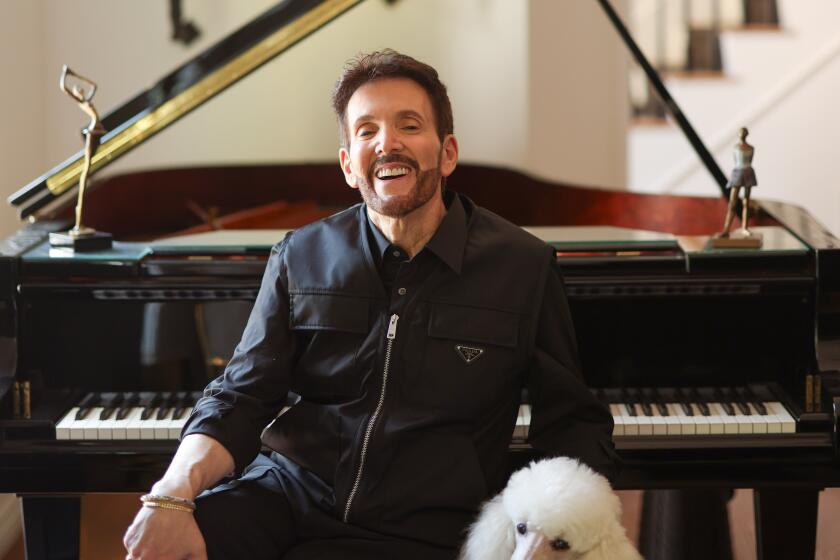Rob Reiner’s ‘Flipped’ is getting careful handling from Warner Bros.
How do you market the sweet and the square in a time of the slick and the hip?
That’s the dilemma facing Rob Reiner’s “Flipped” this weekend. Hollywood studios these days don’t typically make a movie about young love in an early 1960s of ice-cream parlors and bicycle-riding. Or, for that matter, release it in Sacramento weeks ahead of New York.
But little is typical about “Flipped,” which opens across Los Angeles on Friday (as well as in Sacramento and Austin, Texas). Based on a novel from the young-adult author Wendelin Van Draanen, it tells of a precocious girl ( Madeline Carroll, for the bulk of the film) and quietly popular boy (Callan McAuliffe, ditto) from their grade school days into their early teenage years, continually alternating the story from each of their perspectives. Among other things, the title also refers to a flip in affections: At first the girl likes the boy, but he doesn’t feel the same way, then the dynamic is reversed.
The film’s Mayberry backdrop and unabashed preadolescent vulnerability — with its voice-overs and youthful infatuations, “Flipped” recalls “The Wonder Years” but with far fewer intrusions from the outside world — would stand out in any era. In today’s moviegoing climate, it’s an eye-popping curiosity. The company behind the release is even more unusual: The movie is being distributed by Warner Bros., whose other summer releases include big-budget extravaganzas such as “Inception.”
“We’re in the tentpole business, but every once in a while, it’s good to try something like this,” says Warner Bros.’ president of domestic distribution, Dan Fellman.
With a film that runs so counter to the zeitgeist, Warner Bros. has needed to get creative — namely, by using that discordance to its advantage. It sent Reiner to cities such as Indianapolis for a screening with an outfit called the Heartland Film Festival, which also offered up a quote for some of the television spots. (Reiner said that “by holding word-of-mouth screenings and events in markets which are not so accustomed to Hollywood screenings we generated a lot of attention and terrific reaction.”)
And in its television campaign, the studio even uses an endorsement from the Parents Television Council (“Charming and delightful,” the group calls it), in notable opposition to the campaigns from the likes of the CW show “Gossip Girl,” which turns the disapproval of the very same PTC into part of its appeal.
Yet, for all the film’s solidly American values, going after the faith-based audience that has been key to movies such as Warner Bros.’ own “The Blind Side” is difficult, primarily because, for many, Reiner is perceived as a classic Hollywood liberal; he even played one in prime time.
The idea behind all of this is to do what studios rarely do anymore. “With many movies, it’s about hitting all these benchmarks,” says Warner Bros.’ president of worldwide marketing, Sue Kroll. “With this campaign, it’s about conveying how the movie makes you feel.”
Indeed, nostalgia is an important part of the strategy, especially for those who were, like the film’s protagonists, young in the middle of the century. “It was a time for friends, a time for family,” one spot begins, and Warner Bros. has arranged screenings and advertising with the AARP.
Attracting children — the age group that gets the most screen time in the film — will prove trickier. The movie is marketed as coming from the director of “Stand by Me,” but it’s so starkly different than anything most children today see that getting them into theaters is a challenge. Still, the studio wants exactly that and has held screenings in conjunction with the Boys and Girls Clubs.
One night earlier this week at the Edwards 26 in Long Beach, more than a hundred children had gathered to see an advance screening of the film. As the movie played, many laughed — the period setting allows children to poke fun at their insecurities from a safe distance — but some were more skeptical. “We should have seen ‘Inception,’” one boy of about 9 could be heard saying.
The distribution strategy is almost as unconventional. Typical thinking says that studios should release a movie to thousands of theaters at once or, alternatively, use a platform release that targets a select few upscale theaters in coastal cities.
Yet Warner Bros. chose to open only in L.A., Sacramento and Austin — but in an average of a dozen theaters in each city, in a way that enables it to save money on a costly national release but still get the word out to the mainstream. “This gives us a chance to sample the suburbs,” Fellman says. Fellman says the studio will use the box-office totals from these venues to decide how many theaters to open in on Aug. 27, when the film widens to other cities.
Some of this is not unfamiliar territory for Warner Bros., which went out slowly with another life-affirming movie, Reiner’s previous “The Bucket List,” gradually bringing it to more than $170 million in global box office. And “The Blind Side” targeted heartland audiences to lucrative effect. But “Bucket List” contained two highly marketable stars in Jack Nicholson and Morgan Freeman. And some of the heavy lifting on “Blind Side” was handled by specialty marketing firm Grace Hill Media.
Kroll acknowledges the challenges but says that she and her team relish them. “It’s a bit of an adjustment, but not really that much of one,” she says. “They key is just having the strongest voices in a given environment, no matter what the environment might be.”
steve.zeitchik@latimes.com
More to Read
Only good movies
Get the Indie Focus newsletter, Mark Olsen's weekly guide to the world of cinema.
You may occasionally receive promotional content from the Los Angeles Times.











